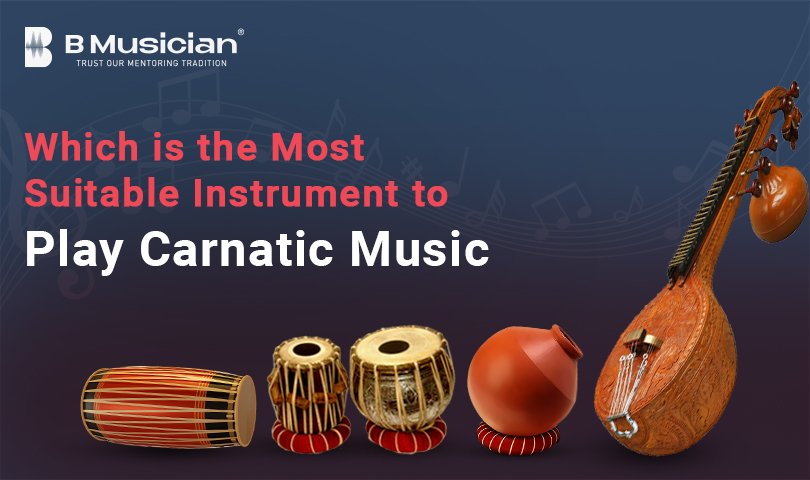Suitable Instruments to Play in Carnatic Music
Carnatic music is one of the two main classical music traditions of India, the other being Hindustani music which is indigenous and popular in the Northern part of the country.
Carnatic music as a genre has its origins from the southern part of India, encompassing the states of Tamil Nadu, Karnataka and Kerala.
Carnatic Music Classes Online:
As a genre propagating Rich cultural heritage, artistic expression, intellectually challenging, Global recognition and most importantly for personal growth – online carnatic music classes has been a sought after genre to be learned and performed. Everyday millions of students, avid learner, scholars, discover the genre with renewed passion.
Given the significant advances in technology and increasing global demand for the genre to be learnt- online learning of Carnatic music as genre has become quite popular amongst the masses.
The accessibility to quality musical education under reputed gurus regardless of your geographical location, Flexibility in timing/learning, variety of learning tools to support you and overall community and networking opportunities makes Online learning of Carnatic Music very much sought after.
Let’s dive in and learn some aspects of Carnatic music focusing on History, type of instruments used and comparative study of instruments like Veena-Violin- Guitar in the overall learning process.
Historical, Structural and Cultural Background of Carnatic Music:
Carnatic Music has its roots to ancient times, with its development traced back over 2000 years. It is deeply embedded in the devotional and cultural practices of South India.
Learning as an aspect has innate benefits and roots to cultural practices thereby inculcating a strong sense of community, devotion and emphasis on personal growth and development .
The Guru Shishya-Prampara/Tradition is a practice where the learning happens through a direct mentor-student relationship. Traditional methods emphasise oral transmission of knowledge and practical training.
Structured learning methodologies include training young students in a rigours regimen of Foundation lessons, basics and slowly transcending across complicated exercises, Geetha’s, Krithis and other compositions. This ensures the student has a wide exposure to different compositions with a strong foundation in basics.
Learning Carnatic music not only provides the student with the abilities and skills to perform the art but also imbibes a foundation principle of discipline, devotion, faith and respect to culture.
Carnatic music performances are usually in the standard Kutcheri setup which usually is combined as part of larger festivals, celebration etc which strengths a stronger bond of community, relationship etc.
Apart from the human voice predominantly adding value and flavour to Carnatic music, it features and employs a variety of traditional instruments. Each instrument brings its unique sound and role to performances. These instruments have a rich cultural heritage, history and applicational practices by themselves in the genre of Carnatic music.
Carnatic Music and its Repertoire of Instruments:
Veena: A plucked string instrument with a rich resonant tone. It is one of the oldest instrument in Carnatic music and is used for both solo performances and as accompaniment. The instrument consists of a combination of Wood shaped into a long neck with Grooves or frets across which strings are attached and stretched (creating sound because of tension) and two hollow resonator Gourds are used in the front end and the back end of the instrument.
Mythological fact: Veena is the favourite instrument of serval important deities in Indian Plethora of gods, including goddess Saraswathi, the goddess of Arts and learning. The Veena handled by Goddess Saraswathi is know as “Kachchapi”
Ravana, an ardent devotee of Lord shiva designed the instrument Rudra-veena using one of his 10 heads as the Gourd and his Arm and Nerves as the body and strings of this instrument, thereby impress Lord Shiva with his devotion.
Violin: The violin is bowed string instrument played in a seated position or upright standing position and is used for both melodic and accompaniment purposes.
Historical fact: Even though being predominantly used in Carnatic Music, Violin is not a Carnatic instrument. It was introduced to Carnatic Music tradition in the 18th Century by the Italian Missionary and violinist Domenico Palumbo who was associated with the court of Maratha King Shrimanth Shahu Chhatrapati, played significant role in integrating the violin into south Indian musical landscape.
The history of Violin in South Indian goes further back than 17th century, where Baluswami Dikshithar- brother of MuthuSwami Dikshitar (one of the Trinities of Carnatic Music) was the first know violinist to infuse the instrument into the genre of Carnatic music.
Mridangam: A double headed South Indian Hand-drum that provides Rhythmic foundation in Carnatic music. Its intricate and complex rhythmic patters are a crucial flavour to Carnatic concerts. The exact origin of Mridangam is unknown but the instrument plays a crucial role in many stories of gods and exists in paintings and sculptures as early as 200BCE.
Mythological reference: The mridangam is often depicted as instrument favoured by Lord Ganesh and Lord Nandhi- the vahana of Lord Shiva.
Ghatam : is a clay pot used as a percussive instrument. It produces a distinct earthy sound and is played using the fingers. The Ghatam traces its origins back to ancient Tamil Nadu, where its traditionally used in temples and folk music.
Mythological/historical reference: The ghatam was first described by Sage Valmiki in the ancient poem Ramayanam dated roughly 500 BE.
Kanjira: is a small farm hand drum with a single metal jingling ring, used for rhythmic accompaniment. It has a bright sharp sound.
The origin of development of Kanjira as an instrument is credited to Manpoondia Pillai who was a temple lantern bearer who sought to study drumming.
Morsing: is a Jaw Harp like instrument that provides rhythmic and melodic support with its distinctive resonant tones. Though its origin in the Indian subcontinent is not too well documented with most ancient accounts being derived from folk tales and secondary source.
Nadsawaram: is a wind instrument similar to to long oboe, known for its powerful and penetrating sound, it is often used in temple ceremonies and festivals. The Nadaswaram evolved from an ancient instrument called Nathuni , which was earlier used by Indian shepherds to communicate with their herds. Overtime, the instrument was modified and refined and the Nadaswaram as we know it today emerged around 15th century.
Flute: is the south indian flute made of bamboo, has a softer mellower tone compared to its north indian counterpart and it is used for melodic and improvisational purposes.
Tambura: is a long necked plucked string instrument used to provide a constant harmonic drone, creating a tonal foundation for the performance.
The Veena and the violin are both string instruments but they have distinct differences in their structure and physiological advantages, reflecting their unique musical traditions and playing techniques.
Structural Différences:
a) Body shape and construction:
Veena: The Veena is a traditional instrument with a large resonating body made of typically of wood with a bowl shaped base. The body often has a significant number of sympathetic strings and is adorned with intricate carvings. The main resonating chamber is usually quite large, contributing to its deep, resonant sound.
Violin: The Violin has a smaller, more compact body with a distinct hourglass shape. It is made from a combination of tone woods such as spruce for the top and maple for the back, sides and neck. The violin’s body is relatively smaller, which affects its sound projection and tonal quality.
b) Strings and Tuning:
Veena: The Veena typically has 7 strings- 4 main playing strings and 3 or more sympathetic strings. The sympathetic strings are tuned to the notes of the raga being played and resonate to enhance the harmonica richness of the sound.
Violin: The violin has 4 strings tuned to perfect fights ( G,D,A,E). The tension and tuning of these strings contribute to its bright and penetrating sound.
c) Playing position:
Veena: played while seated with the instrument held horizontally across the lap, the Veena requires the player to use the fingers or the left hand to press the stings against the frets and the right hand to pluck the strings.
Violin: Played while held under the chin with the neck supported between the jaw and shoulder, the violin requires the player to use the left hand to press the strings directly against the fingerboard and the right hand to draw the bow across all 4 strings.
Physiological Advantages:
a) Sound production:
Veena: Produces a rich resonant sound with characteristic drone from the sympathetic strings. This can provide a fuller harmonic backup in performances. The Large Body allows for deep, mellow tones which are often used in classical Indian music to create a meditative atmosphere.
Violin: The violin’s smaller size allows for greater projection and a brighter more focused sound. The bowing technique enables dynamic range and expressive nuances such as vibrato, and various articulations, which are integral to western classical music and many other genres.
b) Techniques and versatility:
Veena: The Veena’s frets and plucking technique offer precise control over pitch and ornamentation. However the frets can limit the fluidity of pitch bends and slides compared to instruments without frets.
Violin: The violin’s fretless design allows for smooth pitch changes and microtonal adjustments , which is beneficial for techniques like sliding and vibrato. This flexibility allows for a wide range of expression and technical complexity in performance.
c) Physical Ergonomics:
Veena: The Veena’s playing position might be considered more relaxed as it is played seated, with the instrument resting on the lap. This position can reduce physical strain but may limit mobility and quick transition between notes.
Violin: The violin requires more dynamic posture and physical engagement, involving the use of both arms and shoulders. This can be physically demanding but it allows for a wide range of motion and technique.
Comparative study of Instruments: Violin-Guitar- Veena in Carnatic Music Learning:
| Aspect | Violin | Guitar | Veena |
| Cultural tradition | Widely used in Carnatic music | Less traditional, not typically used in Carnatic music but recent techniques from masters like Mandolin U.Shrinivas and Guitar Prasanna- techniques were developed to using Guitar playing in Carnatic. | Deeply traditional and integral to Carnatic music. |
| Learning Curve | Requires mastering specific bowing techniques and finessing techniques. | Easier for those already familiar with western guitar, may need adaptation of techniques for Carnatic styles. | Steep learning curve due to its unique playing technique and structure. |
| Sound Quality | Rich and versatile- suitable for Carnatic music. | Limited range of traditional Carnatic sounds. But With technique adaptation allows glides and gamakhas. | Distinctive and resonant sound that is characteristic of Carnatic music. |
| Technical Skills | Requires precision in bowing and fingering. | Requires adaption to different tuning and finger puck/slide technique. | Requires mastery of intricate fingering technique and resonant sound control. |
| Repertoire | Extensive Carnatic music scope possible or available. | Limited scope possible to be used in traditional Carnatic element and has more modern interpretations. | Extensive traditional scope available with classical compositions. |
| Portability | Portable and easy to carry. | Very portable and easy to carry. | Less portable, relatively bulky and delicate. |
| Cost | Generally moderate to high, depending on quality. | Generally, moderately and often more affordable. | Often: traditional Veena can be expensive and delicate. |
| Learning resource | Abundant resource and teachers available. | Fewer dedicated resources for Carnatic music available. | Specialised resources and teachers may be less accessible. |
| Performance context | Commonly used in Carnatic music concerts and performances. | Rarely used in traditional Carnatic music performances but new avenues for Carnatic guitar adaptations are opening up. | Intergral to Carnatic music performances. |
| Cultural immersion | Provides a traditional learning experience. | Less immersive in traditional Carnatic context. | deeply immersive and traditional learning experience. |
| Adaptability | Can adapt very well different types of styles of music within and outside Carnatic music. | Specialised adaptation needed for traditional Carnatic music. | Highly specialised, less adaptable to other styles but is open to new rooms of exploration with regards to other genres. |
Tug of War: Veena vs Violin vs Guitar:
Veena is a deep grooved fretted instrument, where the distance between the string and fret allows a long action of string bending (which is utilised along with ornamentation style Gamakha). This enables the artist to play deep gamakhas , utilising slower paced songs. Classic examples will be compositions of Muthuswami Deekshitar, where the songs will have detailed note bends and gamakhas and also while singing expressive Gana ragams like Bairavi, Ahiri etc… The limitations may include the massive size of the instrument and limited fret size may restrict the range of gamakhas. This construction allows limits fluid sliding techniques unlike flat fret board/ Fretless instruments like violin and guitar.
Guitar is a long necked Fretted instrument with flat finger board, allowing the artist to slide in-between notes and frets with ease. Utilising ornamentations like Gamakhas isn’t possible to the extent of a Veena but Guitar techniques also allow note bends and other ornamentation. The limitation may extend during plucking or strumming which limits the instrument from producing fast paced notes like the Violin and rhythmic and deep notes like the Veena.
Violin is a fretless instrument, thereby making it easy for slides, gamakahs and ornamentation to be more fluid and voice like. The violin is known to mimic the closest sound to the human voice, with regards to tonal intricacies. The violin player relies on precise finger positions for microtonal sounds and fast phrases while playing. Limitations may arise while using bow, which restricts or limits the type or varieties of Gamakhas that can be played. The combination of fretless string instrument, mimicking human voice accurately and its ability to rely on bowing techniques for playing fast phrases, might make the violin the most apt instrument to be used in Carnatic music.
Then again, this might be my personal favourite, whats your?
Inference:
Overall, the variety and specialisation of instruments in Carnatic Music reflects the tradition’s richness and complexity, allowing a wider range of expressiveness and possibilities.
Learning the instruments of Carnatic genre, like any other instruments all around world comes with a wide range of positive attributes like personal discipline, less stress and calm state of mind, introspectiveness, connection to culture and tradition etc.
So What are yo waiting for look up your personalised Carnatic Music classes online and get enrolled- begin your journey of learning this wonderful mystical Genre from South India.
























